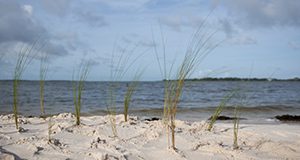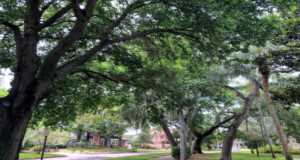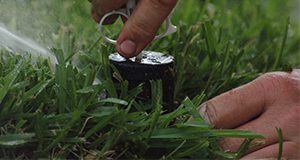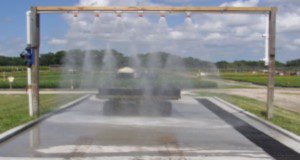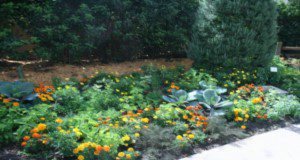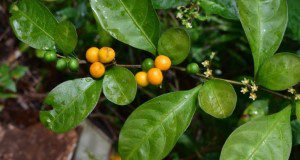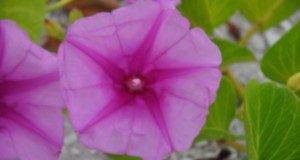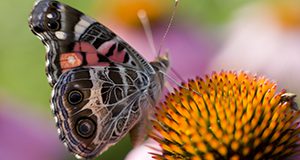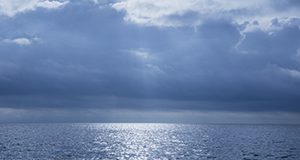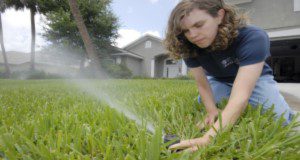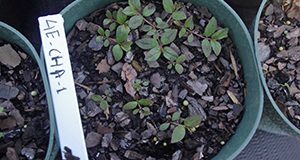The impacts of sea level rise on ecosystems and natural resources are a major concern in Florida, especially in low-lying coastal areas such as south Florida. Sea level rise can impact many aspects of Florida's economy, including urban development, agriculture, infrastructure, and natural areas. This 16-page document introduces, evaluates, and summarizes selected available online sources and tools to educate diverse stakeholders and concerned local residents on important aspects of sea level rise. Written by Young Gu Her, Ashley Smyth, Jiangxiao Qiu, Elias Bassil, Ulrich Stingl, and Laura Reynolds, and published by the UF/IFAS Department of Agricultural and Biological Engineering, June 2020.
https://edis.ifas.ufl.edu/ae543
Category: Environment
FRAGSTATS: A Free Tool for Quantifying and Evaluating Spatial Patterns

Human activities such as urbanization and agriculture have triggered rapid land cover change, resulting in the loss of natural ecosystems. Land managers managers seeking to plan effectively for future land use that preserves biodiversity and the valuable services provided by natural ecosystems must understand land cover change and its environmental impacts. Quantifying patterns of land cover change objectively in order to understand them can be difficult without the proper resources, however. This 9-page fact sheet written by Benxin Chen and Basil V. Iannone III and published by the UF/IFAS School of Forest Resources and Conservation introduces one such resource, a free software called FRAGSTATS. Readers will learn to create input data, run the FRAGSTATS software, and interpret outputs. A few basic concepts of landscape ecology and GIS are included, but this fact sheet is intended for readers with at least some GIS knowledge.
https://edis.ifas.ufl.edu/fr431
Florida’s Urban Forest: A Valuation of Benefits
This new 13-page article combines canopy coverage data from all of Florida’s metropolitan and micropolitan areas with ecological models developed by the USDA Forest Service to calculate several key benefits of urban trees and an approximation of their monetary value. Benefits of urban trees include carbon sequestration/storage, air pollution filtration, and stormwater mitigation. Written by Drew C. McLean, Andrew K. Koeser, Deborah R. Hilbert, Shawn Landry, Amr Abd-Elrahman, Katie Britt, Mary Lusk, Michael G. Andreu, and Robert J. Northrop, and published by the UF/IFAS Environmental Horticulture Department.
https://edis.ifas.ufl.edu/ep595
Florida H2OSAV Insights: Home Water Use in the Gainesville Regional Utilities (GRU) Service Territory
This 6-page fact sheet discusses basics about water consumption for single-family, detached homes served by Gainesville Regional Utilities, information about the highest water users, and impacts of irrigation on water consumption. Written by Nick Taylor, Kaitlin Olander Robb Price, Bradley Spatz, Tricia Kyzar, and Pierce Jones, and published by the UF/IFAS Department of Agricultural and Biological Engineering, September 2020.
https://edis.ifas.ufl.edu/ae544
How Much Space Does My Shade Tree Need? Planting Space Recommendations for Medium and Large Trees in Florida Cities
Trees provide urban landscapes with shade, beauty, and habitat. They can also help lessen the effects of flooding and urban heat buildup while storing carbon dioxide, a major greenhouse gas. When planted in the wrong place, however, trees can damage urban infrastructure. To maximize the benefits provided by urban trees, we need better-informed tree selection and larger planting spaces with the capacity to support big-canopy trees. This new 8-page fact sheet is intended to help arborists, urban foresters, landscape designers, landscapers, and anyone else responsible for the planting of trees in developed areas make informed decisions regarding the planting width requirements of the trees they select. Written by Deborah R. Hilbert, Andrew K. Koeser, Brooke L. Moffis, JuWanda G. Rowell, and Drew C. McLean, and published by the UF/IFAS Environmental Horticulture Department.
https://edis.ifas.ufl.edu/ep592
Watering Station Best Management Practices for Container Nurseries
Watering stations are specialized irrigation structures where plants are watered immediately after transplanting. Water not retained by the container substrate as well as water falling between containers becomes runoff. This runoff can contain sediment and nutrients, such as nitrogen and phosphorus, that can impact natural waters if not managed according to Best Management Practices (BMPs). The purpose of this new 3-page fact sheet is to provide examples of how runoff from watering stations at two nurseries was managed after implementation of the BMP. Written by Tom Yeager and published by the UF/IFAS Environmental Horticulture Department.
https://edis.ifas.ufl.edu/ep590
Edible Landscaping Using the Nine Florida-Friendly LandscapingTM Principles
Maintaining edible landscapes in a way that protects the environment is an important concern for protecting Florida’s water quality. The objective of this new 7-page publication is to introduce the framework of the Florida-Friendly Landscaping™ principles and apply the principles to guide decisions about Best Management Practices (BMPs) for care of edible landscapes. Written by Tiare Silvasy, Lynn Barber, Esen Momol, Tina McIntyre, Tom Wichman, Gail Hansen, Jen Marvin, Terra Freeman, Joseph Sewards, Wendy Wilber, and Jacqlyn Rivas.
https://edis.ifas.ufl.edu/ep594
Chicken of the Woods (Laetiporus sulphureus species complex)
Species in the Laetiporus sulphureus species complex, also known as “chicken of the woods” mushrooms, are wood-decay fungi that cause brown rot within the heartwood of their tree hosts. The common name “chicken of the woods” is given to some species in this group because they are tasty edible mushrooms. Several Laetiporus species have been harvested to use as food colorants, to dye natural products such as wool, and for human consumption. This new 4-page publication of the UF/IFAS Plant Pathology Department, written by Brianna Benitez, Claudia A. Paez, Matthew E. Smith, and Jason A. Smith, describes these fungi as well as their ecology, management, and potential edibility.
https://edis.ifas.ufl.edu/pp358
Septic Systems and Springs Water Quality: An Overview for Florida
Wastewater carries pathogens, nutrients (nitrogen and phosphorus), and trace organic chemicals that may be harmful to human health and ecosystem functioning. Thus, proper treatment of wastewater is crucial. While septic systems can be one means of effective wastewater treatment, there are some special considerations for their use in Florida because of unique geography and sandy soils. The purpose of this new 6-page publication of the UF/IFAS Department of Soil and Water Sciences is to explain the basics of how septic systems work and how they can affect springs water quality in Florida, with a special emphasis on potential N loading from septic systems. This document is intended for homeowners, the general public, and county, city, and other local personnel tasked with managing water quality in areas with septic systems. Written by Mary Lusk, Andrea Albertin, Whitney Elmore, William Lester, and James Moll.
https://edis.ifas.ufl.edu/ss693
Attitudes about Sea-Level Rise Adaptation: Comparison between Miami-Dade County and the Rest of Florida

Sea-level rise and climate change are important issues in science, politics, and communities. Sea-level rise is a particularly contentious topic in Florida, where expected impacts include coastal flooding, shrinking shorelines, and saltwater intrusion. It is unclear what Floridians think about sea-level rise and the ways in which the state can adapt to these impacts. This 5-page fact sheet written by Bailey Emrick, Misti Sharp, and Xiang Bi and published by the UF/IFAS Food and Resource Economics Department summarizes findings from two recent surveys examining attitudes of Miami residents and those of residents of the rest of Florida about sea-level rise and potential adaptations to it.
https://edis.ifas.ufl.edu/fe1084
A Beginner’s Guide to Water Management—Common Aquatic Birds Using Florida Lakes
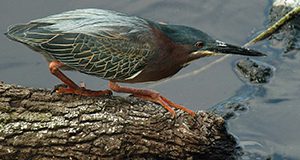
Florida LAKEWATCH is a citizen scientist program that monitors Florida's lakes. Since it was established in 1991, Florida LAKEWATCH has worked with thousands of volunteers to collect water quality data on more than 2,700 aquatic systems in Florida. It is the most comprehensive and longest-running water quality data source in the United States, if not the world. This 18-page circular written by Mark V. Hoyer and published by the UF/IFAS Program in Fisheries and Aquatic Sciences of the School of Forest Resources and Conservation describes Florida LAKEWATCH's volunteer aquatic bird-monitoring program. Citizen volunteers can provide a comprehensive and intimate understanding of birds and their interactions with Florida lake systems, helping to detect the changes in the types and numbers of birds using lakes that may indicate important natural or human-caused environmental trends. Whether you want to identify birds you’ve spotted or take an active role in the management and conservation of Florida's natural resources, this circular can help you learn the basics.
https://edis.ifas.ufl.edu/fa229
The American Horseshoe Crab (Limulus polyphemus)
American horseshoe crabs (Limulus polyphemus) look prehistoric and in fact really have not changed very much in the 200 million years they have been around. This 3-page fact sheet written by Savanna Barry, Holly Abeels, and Shelly Krueger and published by the UF/IFAS Program in Fisheries and Aquatic Sciences, School of Forest Resources and Conservation tells the story of these interesting and valuable “living fossils,” including their importance both to ecology and human medicine. It provides tips on how to find horseshoe crabs and a few ways you can help them.
https://edis.ifas.ufl.edu/sg190
Peters’s Rock Agama in Florida

Florida has experienced more introductions of nonnative reptiles than any other region on Earth. Approximately three times as many species of established, nonnative lizards live in the state as do native species. This 5-page fact sheet written by Kenneth T. Gioeli and Steve A. Johnson and published by the UF/IFAS Department of Wildlife Ecology and Conservation provides background information about the visually striking Peters's rock agama, including information about its introduction to Florida, as well as its biology, conservation issues, and management recommendations.
https://edis.ifas.ufl.edu/uw476
Urban Tree Selection for Diversity
Urban tree diversity is important when attempting to create a healthy, beneficial, and resilient urban forest. Having a variety of trees can increase the aesthetic value for residents and create habitats for plants and animals. Some common street trees currently in the landscape are not site-appropriate and create infrastructure damage. By planting different types of trees in these locations, maintenance costs and infrastructure damage can be reduced and tree longevity increased. This new 4-page fact sheet is intended to provide urban foresters, arborists, landscape designers, and others in charge of tree planting with a process for introducing new species into the urban environment. Written by Deborah R. Hilbert, Andrew K. Koeser, and Robert J. Northrop, and published by the UF/IFAS Environmental Horticulture Department.
https://edis.ifas.ufl.edu/ep589
Distribution, Identification and Management of Two-Leaf Nightshade (Solanum diphyllum), an Invasive Plant in Florida
Two-leaf nightshade, Solanum diphyllum, is a member of the Solanaceae or potato family. It is native to Mexico southwards to Costa Rica. It has escaped cultivation in Florida and grows as far north as Duval County and from Volusia County south to Miami-Dade County. A “bird-dispersed” volunteer, it occurs in urban and conservation areas and on disturbed land. The plants produce abundant berries with many many small seeds. This new 5-page publication of the UF/IFAS Environmental Horticulture Department is primarily intended for Florida gardeners, landscapers, and land managers, and it contains information on identification, flowering, fruiting, and management recommendations for this widely occurring plant. Written by Stephen H. Brown, Chris Marble, and Stephen F. Enloe.
https://edis.ifas.ufl.edu/ep588
Railroad Vine (Ipomoea pes-caprae): Identification and Uses
Railroad vine is one of the most widely distributed beach plants in the world. The moving sand and salt spray make the beach environment a harsh one, and the plants that live there are specialized to colonize this environment. This new 7-page document, published by the UF/IFAS Environmental Horticulture Department, describes railroad vine’s leaves, flowers, fruit, planting and maintenance, and insect and disease problems. Written by Stephen H. Brown and Marc S. Frank.
https://edis.ifas.ufl.edu/ep587
Are consumers knowledgeable about neonicotinoid insecticides and pollinator-friendly plants?
What does the general public know about neonicotinoids used in ornamental horticulture and their effects on pollinators? The question is an important one given that home landscapes serve as pollinator habitat and can impact pollinator health. This 5-page fact sheet written by Hayk Khachatryan, Xuan Wei, and Alicia Rihn and published by the UF/IFAS Food and Resource Economics Department summarizes a survey addressing consumer knowledge about neonicotinoids and pollinator plants, as well as their interest in enhancing pollinator health. The survey is part of a larger research project aimed at incorporating pollinator conservation into the ornamental horticulture industry's sustainability initiatives.
https://edis.ifas.ufl.edu/fe1081
Ocean Acidification: pH Variability across Space and Time
The absorption of atmospheric carbon dioxide by the oceans has changed the chemical properties of seawater and made it more acidic all over the world. Florida, with an extensive coastline and deep cultural and economic ties to marine resources, will be directly affected. This 4-page fact sheet written by Lisa Krimsky, Joseph Henry, and Joshua Patterson and published by the UF/IFAS Program in Fisheries and Aquatic Sciences, School of Forest Resources and Conservation focuses on the spatial and temporal variability in oceanic pH and provide an overview of pH variability in Florida's coastal waters.
https://edis.ifas.ufl.edu/fa227
Homeowners’ Preferences for Smart Irrigation Systems and Features
Drought conditions make landscape irrigation and reducing water use top-of-mind for many Floridians. Encouraging wise water use is of particular importance to the smart irrigation industry and water policy makers. This 5-page fact sheet written by Hayk Khachatryan, Alicia Rihn, Dong Hee Suh, and Michael Dukes and published by the UF/IFAS Food and Resource Economics Department pinpoints key attributes and barriers affecting consumers' irrigation purchases and their adoption of smart irrigation technologies.
https://edis.ifas.ufl.edu/fe1080
Biology and Management of Garden Spurge (Euphorbia hirta) in Ornamental Crop Production
Garden spurge is a prostrate, herbaceous, short-lived, warm-season annual weed commonly found in Florida landscapes, container nurseries, and other agricultural production areas. This 5-page article is written to aid green industry professionals and others in the identification and management of garden spurge in and around ornamental plants. Written by Thomas Smith, Chris Marble, Shawn Steed, and Nathan Boyd, and published by the UF/IFAS Environmental Horticulture Department, July 2020.
https://edis.ifas.ufl.edu/ep586
